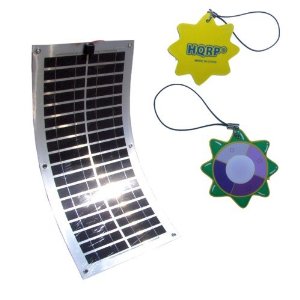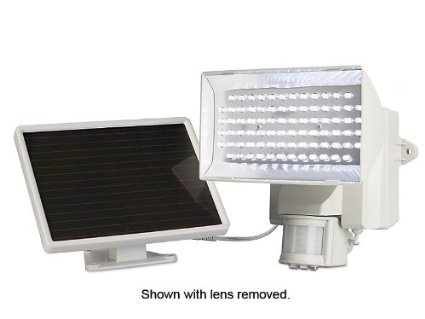Sunforce 50048 60-Watt Solar Charging Kit
Sunforce 50048 60-Watt Solar Charging Kit
- Amorphous solar charging kit provides up to 60-Watts of clean, free, renewable power
- Designed for RVs, cabins, homes, boats, back-up and remote power use, and more
- Weatherproof, durable solar panels can withstand impacts from hailstones travelling 50 miles-per-hour
- Includes four 15-Watt solar panels with durable mounting frames, a 200-Watt power inverter, a 7-Amp solar charge controller, and a wiring kit with accessories for easy installation
- Built-in, ultra-bright blue LED charging indicator
The Sunforce 50048 60 Watt Solar Charging Kit gives you another reason to love the sun — it’ll help keep your batteries charged. This kit is excellent for cabins, remote power, back-up power, and 12-volt battery charging. The kit includes a PVC mounting frame, 7 Amp charge controller, 200-watt inverter, and wiring/connection cables. And with the built-in blocking diode technology, this charger kit is designed to protect against battery discharge at night. You can also use this kit to maintain the charge on any 12-volt battery for clean, silent operation of various electronics, such as deer feeders and landscaping pumps. The 50048 features a built-in ultra-bright blue LED charging indicator, and is a great choice for automobiles, recreational vehicles (RV), tractors, all terrain vehicles (ATV), boats, electric fences, telemetry and more, and it is even effective on cloudy days. This battery charger kit is made of durable ABS plastic and amorphous solar cells and has a maximum temperatu
List Price: $ 599.99
Price: $ 268.74





Innovative design from China, packaging needs help,
*Update* 6-2010, while my original panels are still running strong so long as I hose them down once a month, I’ve noticed that the PVC pipe provided to hold them in place has become brittle with sun exposure, hence I would now in 20/20 hindsight recommend a coat of Krylon Fusion Dover White Plastic Satin Spray Paint on the PVC parts to prevent UV cracking later in life. I do not think the Krylon Fusion product was available when I first setup my first panels but UV cracking of the support structure could cause panel damage in years 2 and 3.
Meanwhile Amazon got their hands on some obsolete & discontinued Sharp panels (12.5% efficiency vs the new 13.1% efficiency) – if you are serious about needing lots of solar power in a small space, this is a big kit – you can view it here: Sunforce 39126 246-Watt High-Efficiency Polycrystalline Solar Power Kit
My only concern about the kit is that due to the new panels being higher efficiency means it will be difficult to match panels if you find you still need more power later on. The other con on that system is it’s price — $1300+ but you get the wattage, along with a cheap charge controller and inverter, both of which could be upgraded for better system performance. It’s just another solar system to consider in the $5/watt or less pricepoint for DIYers.
Update 9-18-2008 – Still going strong. I am very pleased with the summer power output of these panels. I wash them with a hose 1x/mo to keep the output current up. Measured before washing and after washing the panel efficiency is clearly a factor of how much dirt is on them. No problems long term on a roof though!
Update 2-20-2008 – goes with graph “photograph” #3 above – pink line is power and blue line is amps from the panel x 10 to share the graph. The X axis is panel voltage. Data was acquired using an Agilent dummy load with programmable voltage in 1V steps from 1V to 22V (open circuit voltage on the panel) on a partially cloudy day in winter sun. Expectations are for 2-3 times performace in summer sun provided the panels don’t get too hot. These are on my house roof laying flat on a 3/12 pitch facing due south which is suboptimal but easy for me to do. Be sure to read the photo notes. Sorry about the colors excel defaulted to!
This is a MPPT chart (maximum power point tracking) – you can see that the panels are optimized for charging a 12V wet cell right out of the box. Charge current turns on when battery voltage drops down to 13.0 VDC and turns off at 14.2 VDC with the supplied charge controller in the kit.
The only other interesting fact in 2 months is to keep your panels clean. My maximum current was 5.0 A on a cold morning with bright sun until it rained hard and washed the panels clean. The current went up to 7.0 A maximum right after the rainstorm. Below is the original review – these panels have been running constant for 2 months now into 3 parallel deep cycle marine cells (315 AH) connected to the prosine inverter below to drain the energy made.
When reading the power/current chart you should keep in mind the amps have been multiplied by 10 so they use the same Y axis (so 20A on the chart corresponds to 2.0 A panel current) Watts are actual volts*amps. This was taken in the winter with partial clouds – expectations are for a X3 improvement during summertime but its still february and I’m in the northern hemisphere so we’ll have to wait and see. Basically an MPPT charger won’t gain but a few watts with this panel so it’s not a good investment unless you already have one laying around.
(Begin original review after buying panels)
I never seem to be overwhelmed by the latest shipment of product from China, but this one seems to show some promise and shows signs of good cost engineering and a complete design that can be set up quickly by one person with very little effort. I’d give it 5 stars if it were well packed, but my purchase turned into a shipping fiasco.
Most ALL solar installations are rated in $/watt much like new homes are rated in $/sq ft. We’ll get to the sq ft bit later. Here you are getting 60W for 320 dollars or about 5.33 $/watt. Compared to a similar wattage panel, the BP solar 365U rated at 65W and priced (street) at 399 or 6.13 $/watt the amazon package seems to be a good deal when you consider it comes complete less battery (we’ll hit that one later too)
In fact, the amazon package deal includes a xantrex 175 watt inverter with a .15A “idle” current designed for solar systems where current consumption must be…
Read more
Was this review helpful to you?

|Permanently installed on roof,
The panels are installed on my garage roof, wired in to a battery bank and inverter which primarily functions as a very large (4KW) uninterruptible power supply for the house. So far, everything is working fine. They keep the batteries topped off without using power from the grid.
Like most manufacturer’s specs, the 60 watt claim is hard to realize. The panels’ current output is about 3.2 amps under bright sun, which yields only about 45 watts into a 12 volt gel cell battery at 14.2 volts. The panels can output about 20 volts which would indeed yield 60 watts, but not while connected with the included charge controller. A MPPT controller would achieve 60 watts, however.
The included controller is acceptable in that it works as advertised. One good thing about it is that it does not shunt the panels when the battery is charged, it actually opens the circuit, which means the excess panel output would be available for other uses. I intend to build another device for charging another set of batteries after the primary set is charged.
The included inverter works, but I did not use it in the system. Instead, I’ll just keep it around for a portable inverter.
Also, I did not use the PVC pipe stand included with the system, instead mounting the panels directly to the roof.
The kit did include a variety of connectors allowing use with cigarette lighter plugs and jacks, alligator clips, and hardwire, but the charge controller is only usable if hardwired. I strongly recommend the charge controller be used, as the panels can easily overcharge most any 12 volt battery if a charge controller is not wired in.
Was this review helpful to you?

|Recharges all our stuff,
We bought this a few months ago. We live in Phoenix, AZ (“Valley of the Sun”), so this has plenty of opportunity to work. We have it plugged into 2 marine batteries (like car batteries, but bigger), and we have an inverter connected to those. The inverter is in the house, and the batteries are outside. The wire goes through the wall. We plug things into the inverter.
This was easy to put together. You have to buy the batteries, but this came with everything else.
I can run my laptop all day, as well as recharge the cell phones and Wii remotes. My husband can also run his laptop. If we only get on the laptops after work, we can run them well into the night. I’ve had to switch to grid power a couple of times if I’ve used my laptop all day, but I’ve never had to switch over if I’ve only used it during the evening. (This doesn’t count the few rainy days we’ve had. Yes, once in a while it rains in Phoenix.)
This is not the most efficient solar panel set, but it’s very good for starting out and learning about solar power. It’s inexpensive enough to set up and charge all your rechargeable stuff whenever you need it, as long as you live in a fairly sunny area.
Oh, as an experiment, I plugged the vacuum cleaner into the inverter, which promptly started screaming for help. (The inverter has an alarm, apparently.) This whole set-up CANNOT handle this kind of power draw. You have to unplug everything and turn the inverter off and let it just sit a while and reset before plugging in your lower power things again.
You’re not going off the grid with this set-up, but you’ll save yourself a few bucks a month. And you get to be smug whenever anyone talks about going green. “Well of course, our solar array has lowered our carbon footprint considerabley. Shall we go for an organic smoothie now?”
Was this review helpful to you?

|